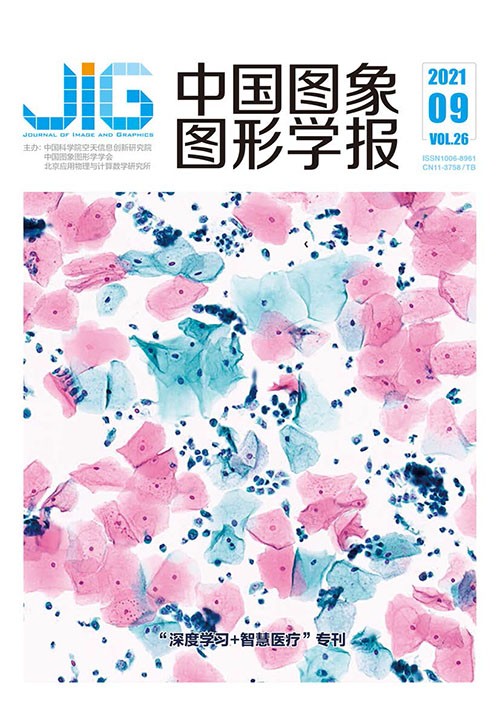
先验权重共享码本下内窥镜图像大肠病变分类
摘 要
目的 大肠息肉和溃疡性结肠炎(ulcerative colitis,UC)是常见的大肠疾病,发病率高,检测需求大,且容易在临床中被漏诊和误诊。因此研究用于内窥镜大肠病变图像分类的计算机辅助诊断(computer-aided diagnosis,CAD)系统十分重要。局域约束线性编码(locality constrained linear coding,LLC)在图像分类领域展现了优异的性能,能够完成对内窥镜中病变图像的分类。但是由于肠胃内窥镜图像中存在的一些微小息肉等病理征状与肠壁十分相似,LLC在这一场景下的性能有待提高。方法 由于码本的设计对细微差别检测能力影响大,本文通过改进LLC中的码本来实现更精确的大肠病变分类,其中原始码本被改进为带有先验权重影响的共享码本。主要思想是尝试尽可能多地使用代表私有部分的码本。本文方法重新排列了码本的列,将较少使用的原子排列在码本的后面,成为共享码本。并利用原子使用的频率计算权重,通过在线字典学习的方法,获得具有先验权重的共享码本。利用这一新码本对特征进行编码能实现更为高效精确的图像分类。结果 为避免过拟合,将部分Kvasir数据集与部分医院合作数据集合并使用。实验在2 600幅内窥镜图像上进行正常、息肉和UC图像的三分类实验,与压缩感知空间金字塔池化(compressed sensing spatial pyramid pooling,CSSPP)方法、私有共享字典学习算法(category-specific dictionary and shared dictionary learning,CSDL)、环形空间金字塔模型方法(circular inner ring partitioning,CIRP)、显著性和自适应局部约束线性编码(saliency and adaptive locality constrained linear coding,SALLC)和AlexNet迁移学习的网络比较,本文方法的总体分类准确率为93.82%,较对比方法分别高了2.33%、2.21%、1.91%、0.8%、0.07%。结论 本文所提出的先验权重共享码本,综合了词汇袋模型和共享字典的思想,使得对内窥镜图像中相似图片的分类更加精确。
关键词
Colorectal lesion classification of endoscopic images based on priori weight shared codebook application
Zhu Tingwei, Li Sheng, He Xiongxiong(College of Information Engineering, Zhejiang University of Technology, Hangzhou 310023, China) Abstract
Objective Colorectal polyps (CPs) and ulcerative colitis (UC) have been the typical colorectal diseases with high morbidity. Colorectal polyps have become the main factor to trigger colon cancers. UC has been an unidentified colorectal inflammatory disease nowadays. The clinical manifestations illustrate the phenomena in abdominal pain, diarrhea, and bloody stools. UC and CPs regard as one key factor to cause colon cancer. High-intensity endoscopic images analyses have intended physician to fatigued. computer-aided diagnosis(CAD)-based endoscopic colorectal disease image classification system has been the essential demonstration. The bag-of-visual-words (BoVW) model has been qualified in medical image classification for endoscopic lesion detection. Locality constrained linear coding (LLC) has been one good quality coding methodology in the BoVW model due to its coding performance and fast iteration speed. BoVW divide an image into many patches to extract its local features. The local features have become scale-invariant feature transform (SIFT) and histogram of oriented gradient (HOG). These local features have been coded via LLC. Spatial pyramid matching (SPM) and maximum pooling have been used to preserve the spatial information of the image. Some small polyps and unidentified UC have not been leaked out from the intestinal wall in the endoscopic image. The performance of LLC codebook has not been classified the similar endoscope images. To realize category-specific dictionary and shared dictionary learning (CSDL), this research has aimed to endoscopic colorectal image classification via learning a priori weight shared codebook in the LLC. The priori weight shared codebook has qualified good classification results via the endoscopic images classification. Method LLC-based priori weight shared codebook has been illustrated. The private features have been represented as much as possible. Two control factors in the LLC cost function have been added in. The rearrangement of the columns for the codebook have been arranged via these rarely used atoms called shared atoms in the bottom of the updated codebook in the coding process. Prior knowledge has been demonstrated to have good performance in image processing. The endoscopic images have potential to the probabilistic priors for image process. A priori diagonal weighting matrix has been added to the shared codebook for the better represent of local features when encoding. The weights have derived from the frequency based on the usage of the atoms. First, the local features have been extracted from image patches. The histogram of local color difference (LCDH) features has been identified the information via the relationship of the color distribution distance instead of the SIFT and HOG features due to the rich color information in the endoscopic images. These features have been clustered into the initial codebook via K-means algorithm. The initial codebook has been updated through online dictionary learning algorithm based on the proposed priori weight shared codebook algorithm. All features have been coded based on the updated codebook. The SPM has been used to preserve the spatial information of the endoscopic images. The support vector machines (SVM) classifier has been trained via the codes to identification the lesion images. Result This research has integrated a part of the Kvasir dataset and a part of the hospital cooperation dataset to resolve overfitting issue. First, the classification experiments have been performed based on 800 polyp images and 800 normal images. The size K of codebook and the size M of the shared atoms have become the main parameters to conduct classification. The results have shown that the classification result played well when K is 256 and M is 56. The accuracy, sensitivity and specificity have been 97%, 96.88% and 97.12% each. The SVM classification accuracy has increased 8.42%, 2.58%, 1.58% respectively compared with vector quantization (VQ), sparse coding SPM (ScSPM) and LLC based on the 1 200 images sample. The illustrated algorithm has presented more robust than LLC based on the small-sized images sample. The dataset has performed classification experiments based on 925 polyp images, 835 normal images and 840 UC images. The accuracy of the classification result has reached 93.82%. The SVM classified accuracy have increased 2.33%, 2.21%, 1.91%, 0.8%, 0.07% respectively compared to compressed sensing spatial pyramid pooling (CSSPP), CSDL, circular inner ring partitioning (CIRP), saliency and adaptive LLC(SALLC) and AlenxNet. The running time has reduced 1 957 seconds in the calculation process. Conclusion A priori weight shared codebook based on locality constrained linear coding has been demonstrated for lesions detection. The qualified classification capabilities have been presented in comparison with BoVW model and other shared dictionary learning. The algorithm has shorten running time to improve the efficiency and accuracy of computer-aided diagnosis to aid clinical diagnosis level. The real-time disease detection based on a completed endoscopic video has been developing further via the applicability of the algorithm murgrading.
Keywords
computer-aided diagnosis(CAD) locality constrained linear coding(LLC) priori weight shared codebook colorectal lesion classification online dictionary learning algorithm
|



 中国图象图形学报 │ 京ICP备05080539号-4 │ 本系统由
中国图象图形学报 │ 京ICP备05080539号-4 │ 本系统由